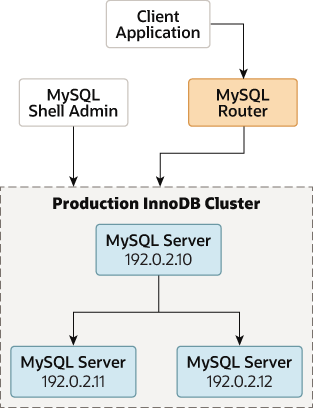- 7.4.1 Pre-Checking Instance Configuration for InnoDB Cluster Usage
- 7.4.2 Configuring Production Instances for InnoDB Cluster Usage
- 7.4.3 Creating an InnoDB Cluster
- 7.4.4 Adding Instances to an InnoDB Cluster
- 7.4.5 Configuring InnoDB Cluster Ports
- 7.4.6 Using MySQL Clone with InnoDB Cluster
- 7.4.7 Adopting a Group Replication Deployment
When working in a production environment, the MySQL server instances which make up an InnoDB Cluster run on multiple host machines as part of a network rather than on single machine as described in Section 6.8, “AdminAPI MySQL Sandboxes”. Before proceeding with these instructions you must install the required software to each machine that you intend to add as a server instance to your cluster, see Section 6.2, “Installing AdminAPI Software Components”.
The following diagram illustrates the scenario you work with in this section:
Unlike a sandbox deployment, where all instances are deployed locally to one machine which AdminAPI has local file access to and can persist configuration changes, for a production deployment you must persist any configuration changes on the instance. How you do this depends on the version of MySQL running on the instance, see Section 6.2.3, “Persisting Settings”.
To pass a server's connection information to AdminAPI, use URI-like connection strings or a data dictionary; see Connecting to the Server Using URI-Like Strings or Key-Value Pairs. In this documentation, URI-like strings are shown.
This section assumes that you have:
installed the MySQL components to your instances
installed MySQL Shell and can connect by specifying instances
created a suitable administration user
